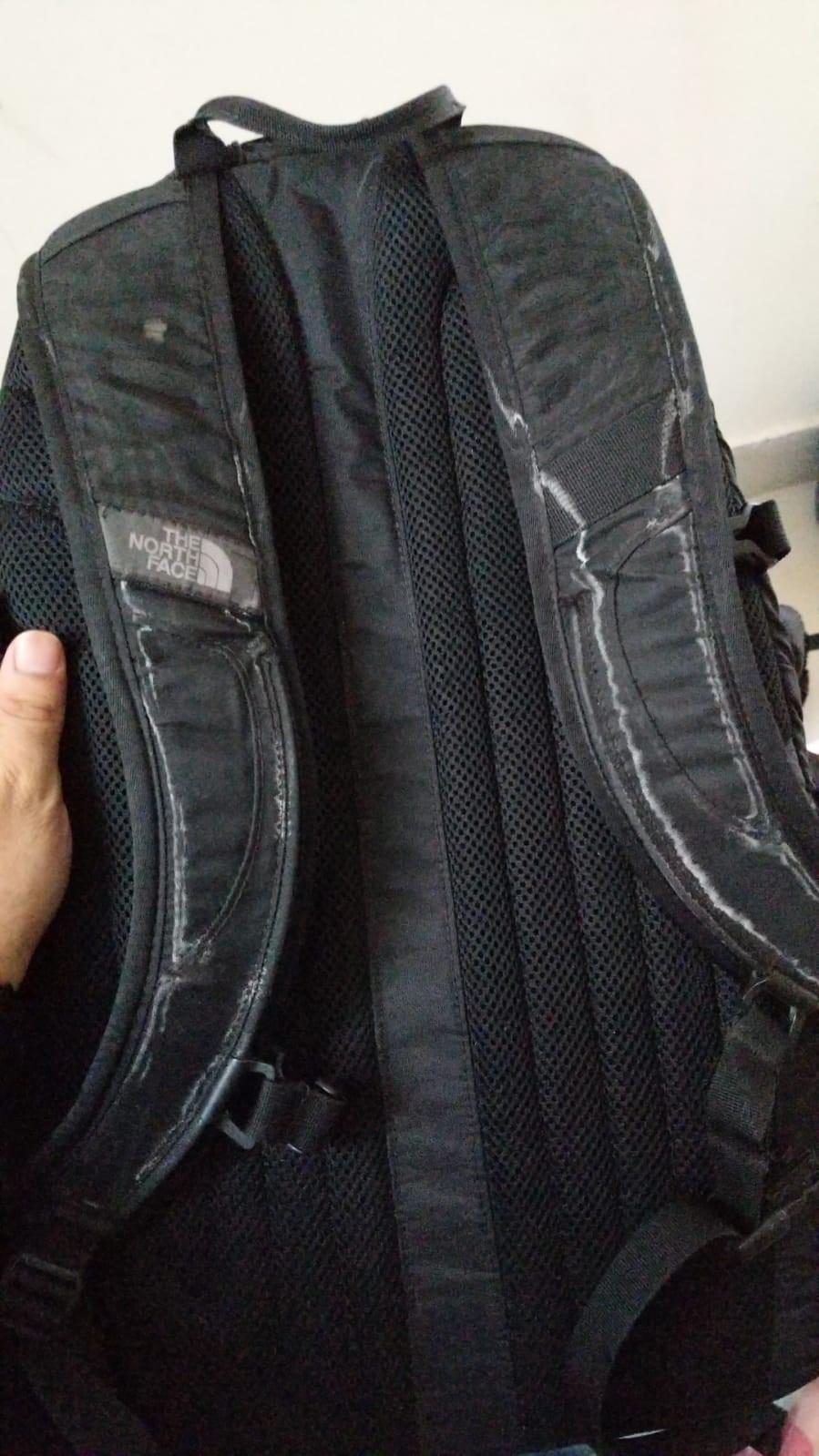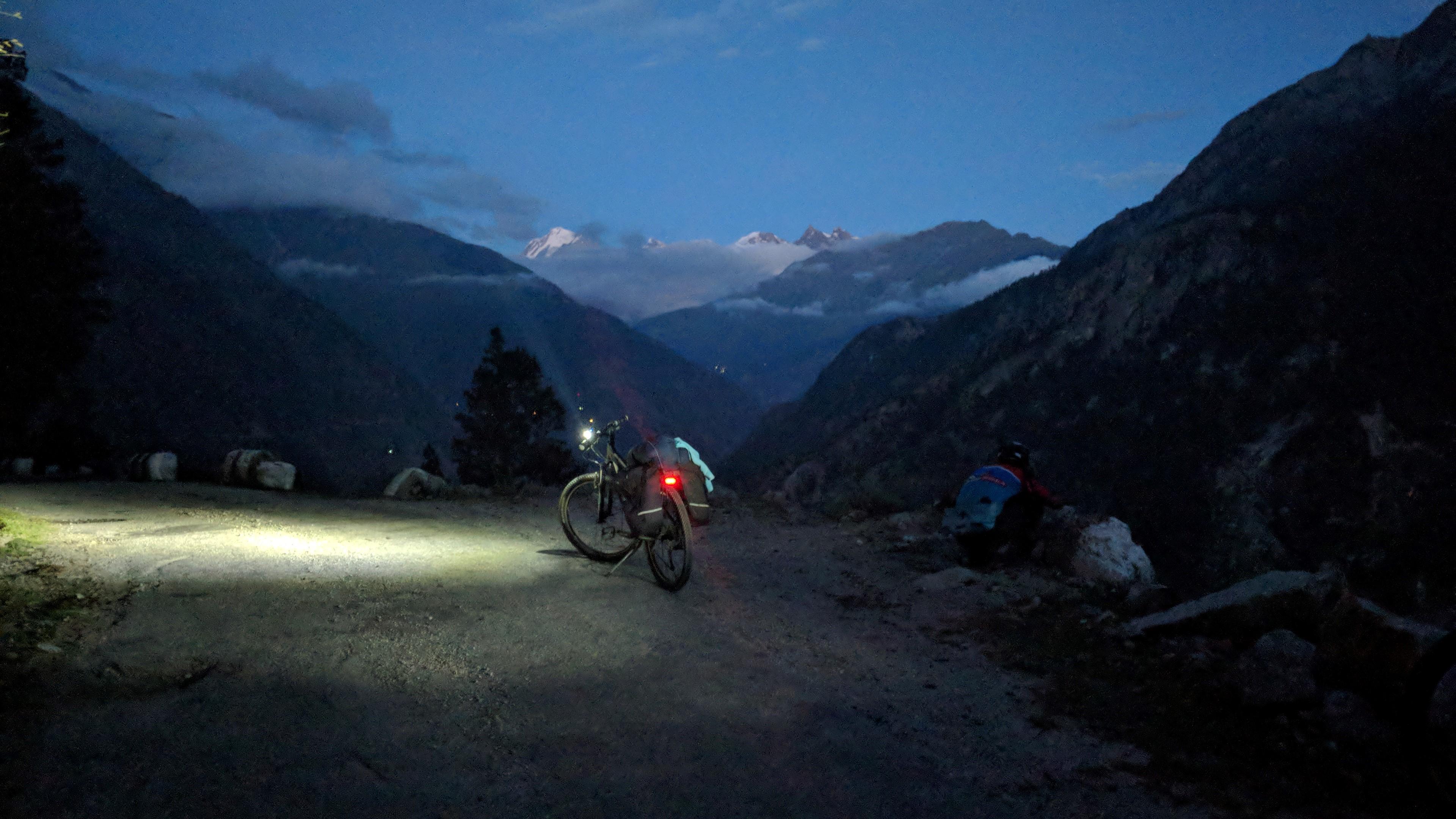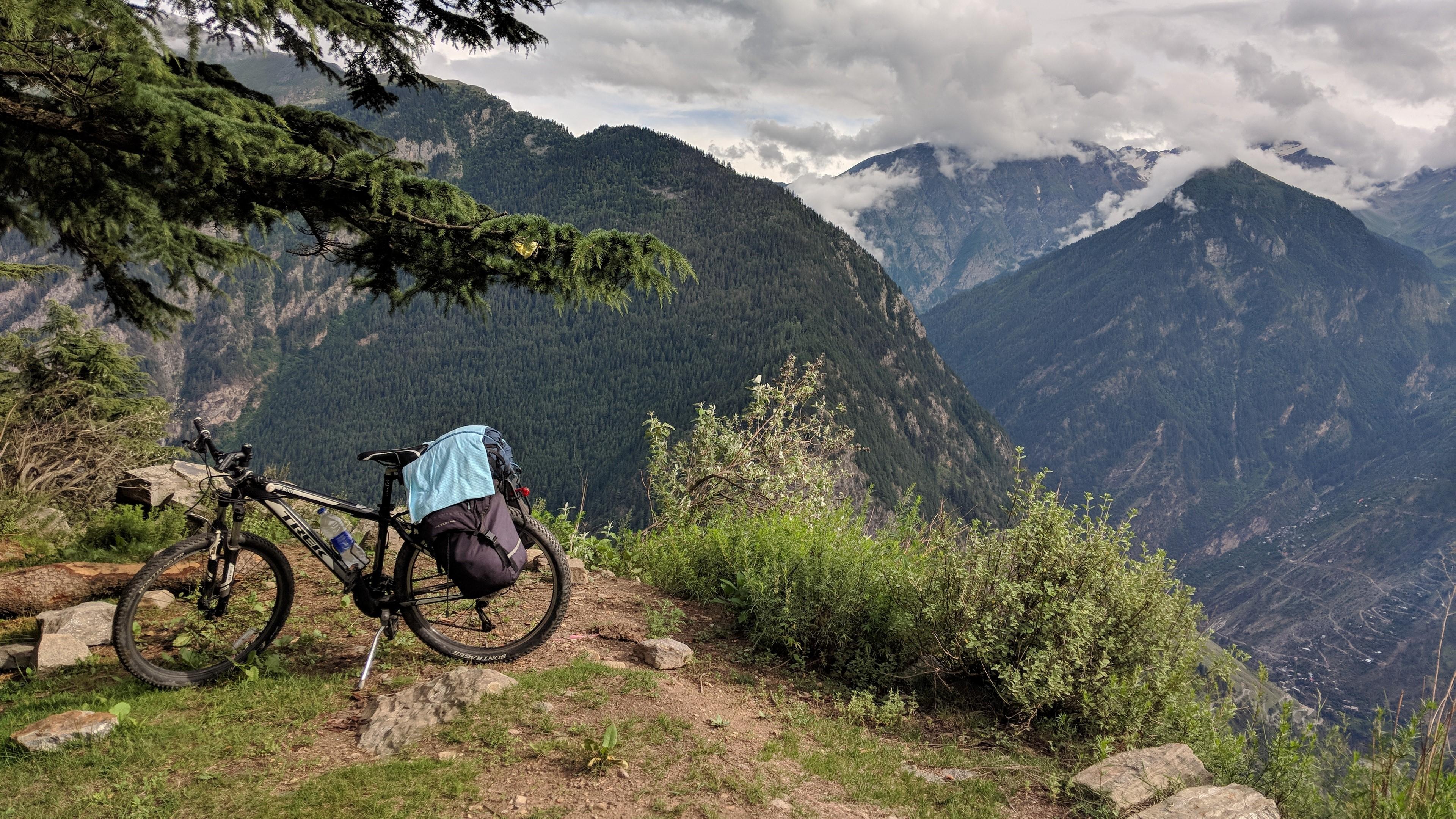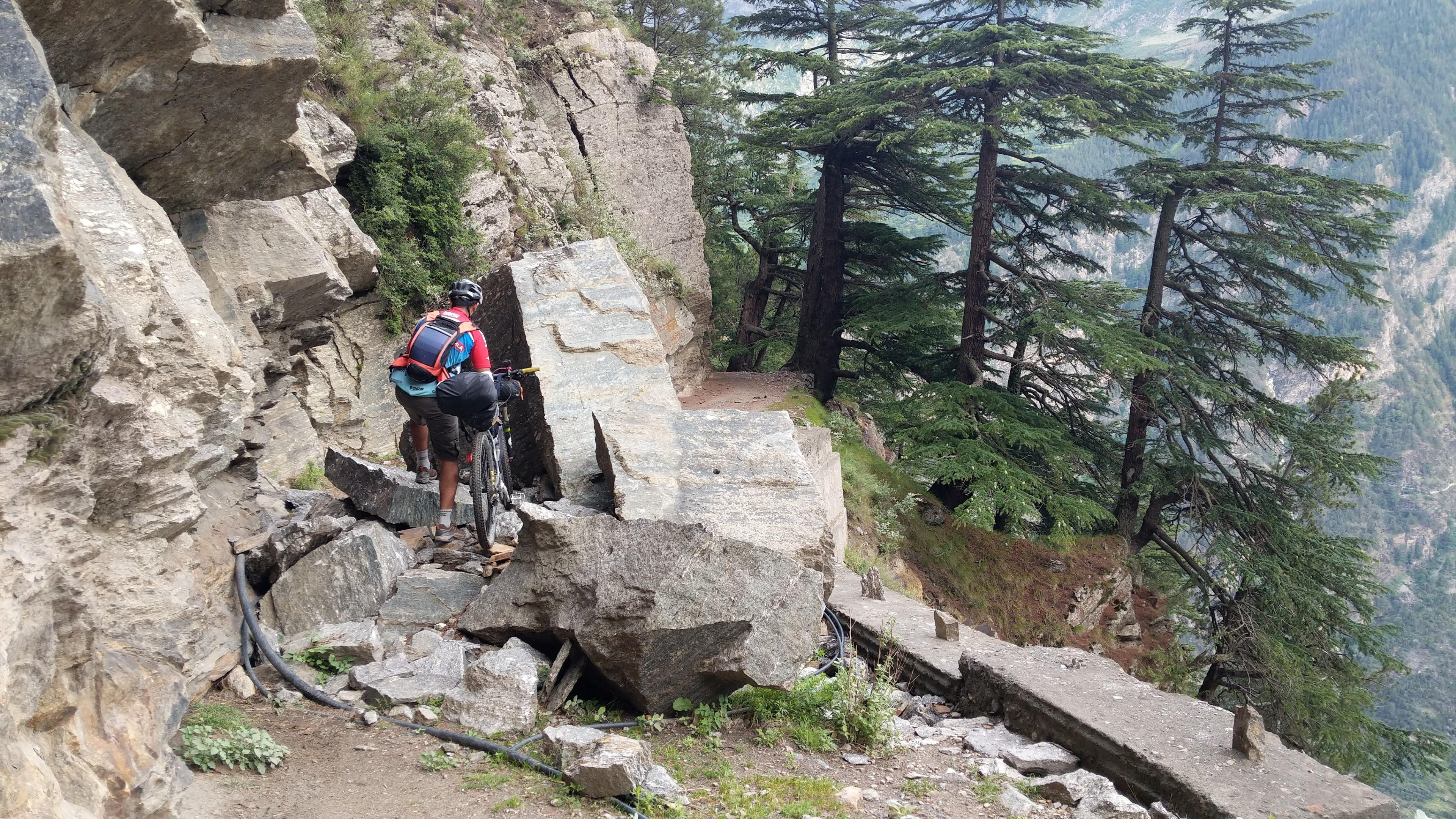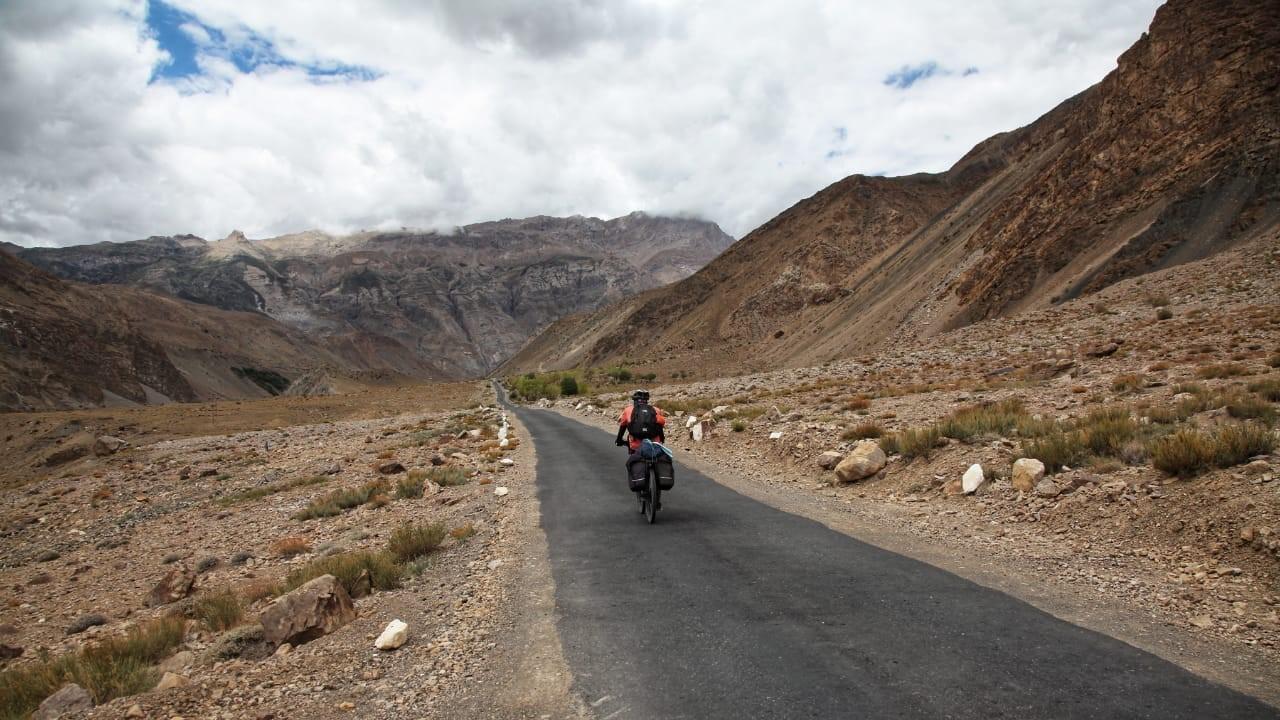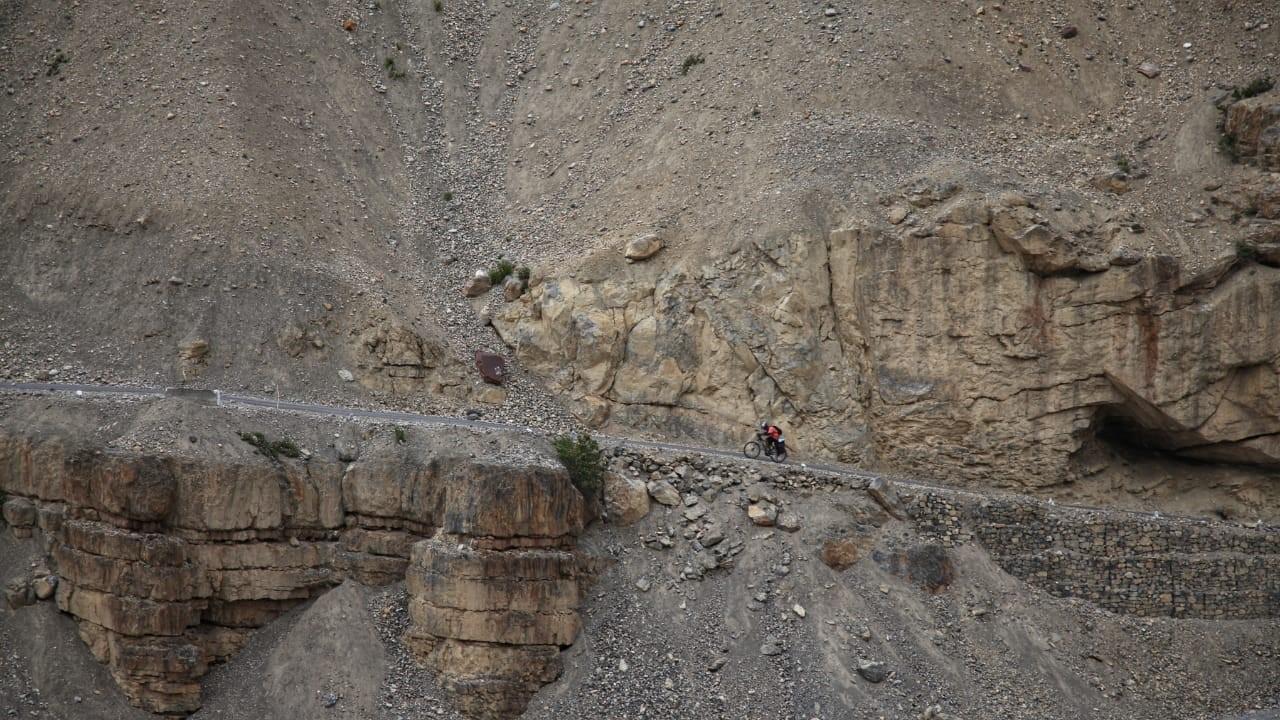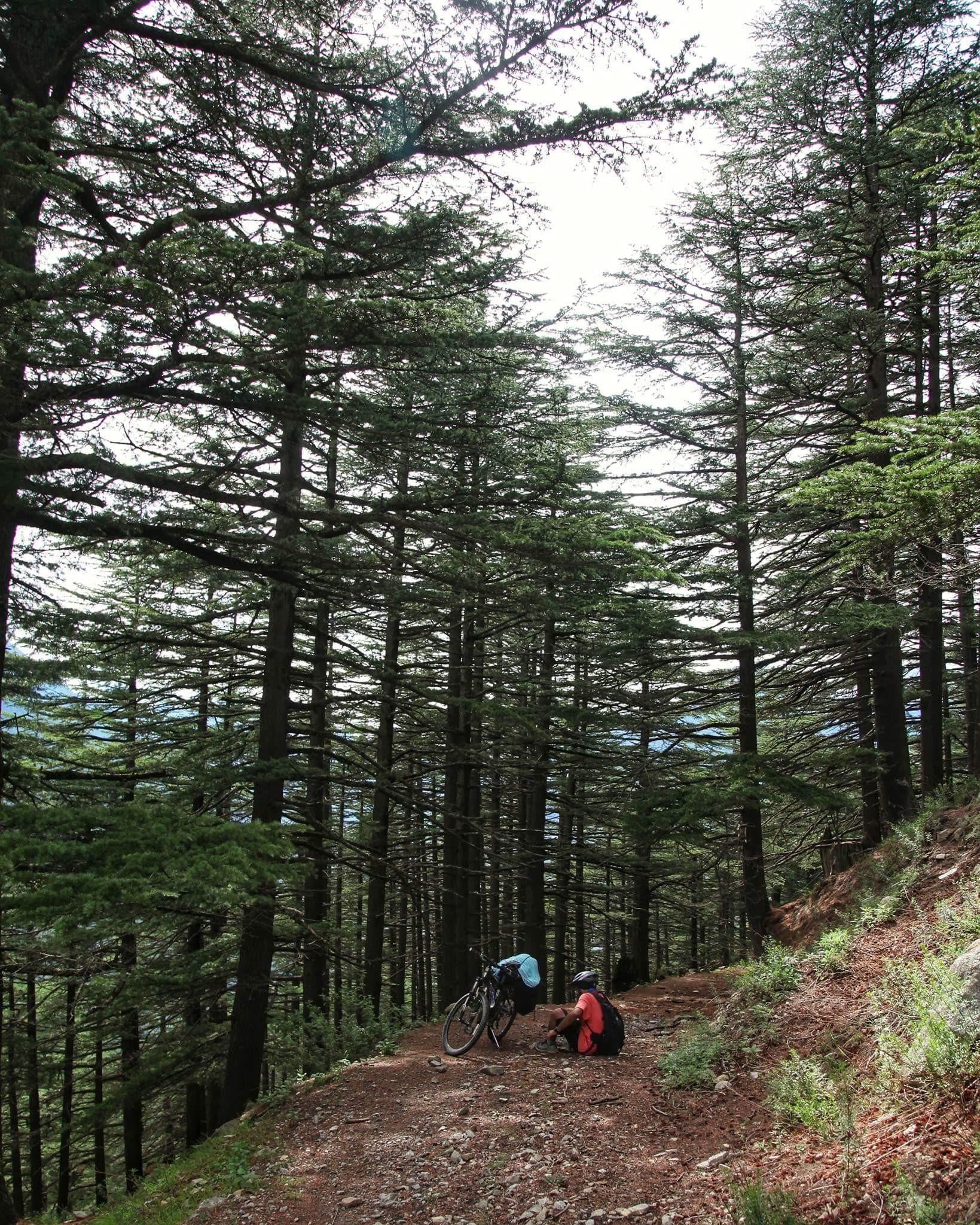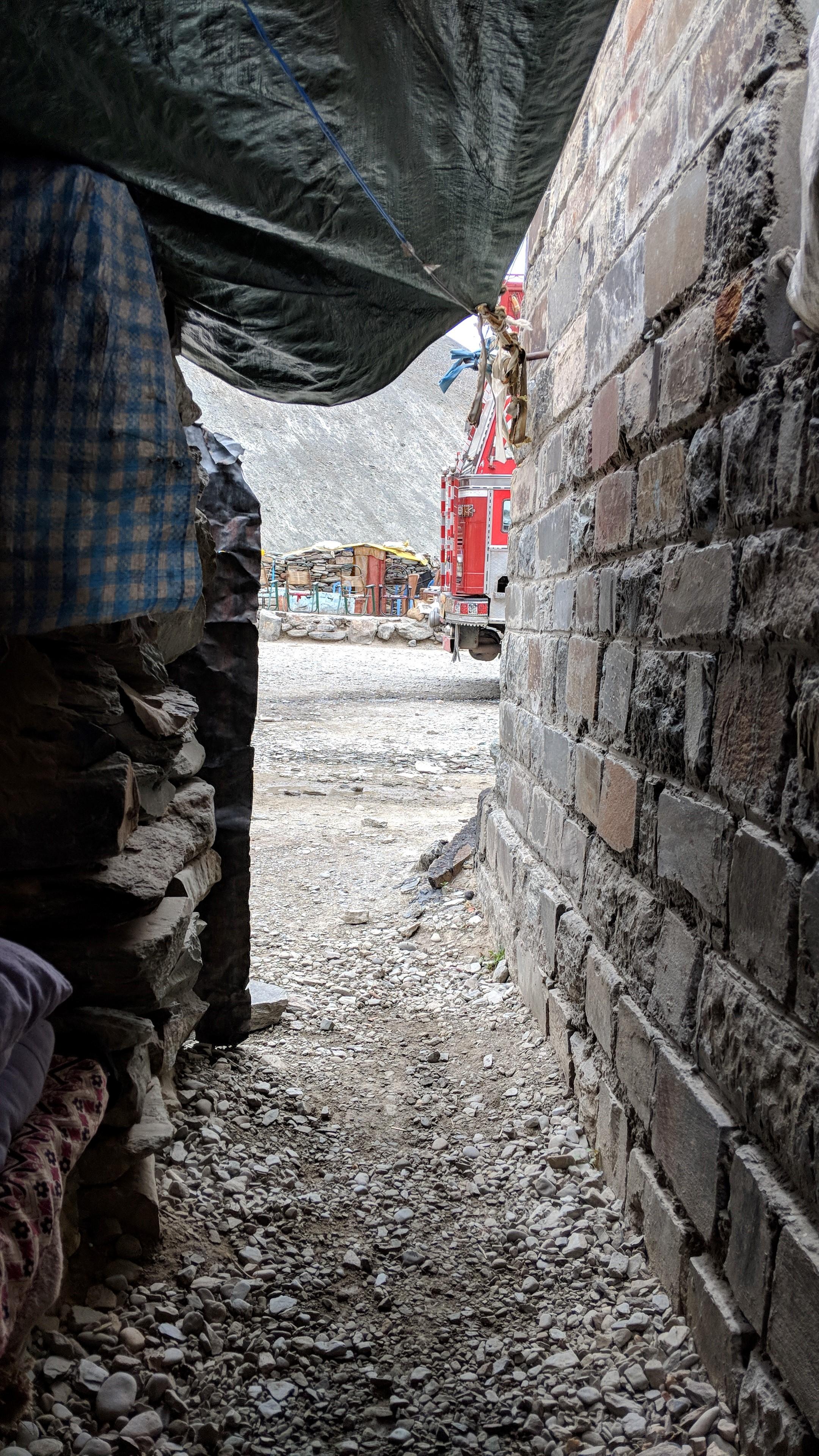Tagged: Himalayas, kumaon, Mtb, Travel, Uttarakhand
- This topic has 1 reply, 1 voice, and was last updated by Avinash.
- AuthorPosts
- 14/05/2020 at 21:50 #3552
“It will be painful right?
Yes it will be.
Very painful?
Yes…”
At this point in the conversation it became clear to me that I was profoundly unprepared for the upcoming trip. After our plans to cycle in Mongolia in 2015 were dramatically altered; I went to America for graduate studies, and Avinash cycled in Mongolia anyway, I was left with a yearning to do a cycling tour, wherever the opportunity. Spiti Valley? Sure! Let’s! Will you train? Yes! I will, I think.
As the day of our departure approached, I felt a strange sense of excitement and dread. I was excited to see what it was like to pedal in the Himalayas. But the dread which gripped my heart kept nagging me to reconsider. What if I can’t do it? What if my body calls it a day and refuses to go further? Why would anyone want to see the mountains anyway? They are big, ancient and daunting. They just stand there! Since I couldn’t satisfactorily answer these questions, I did the only thing I could in the situation; I booked my tickets.
Between July 10-27, 2018, Avinash and I pedaled, pushed, and dragged our cycles around 650 kms between Shimla-Spiti-Manali. The trip was many things; exhausting, painful, frustrating, exhilarating, and at times, frightfully mundane. Rudyard Kipling’s Kim- in a novel by the same name- described Spiti as ‘a world within a world’. I would humbly call it a world of ever-changing landscapes. Like a flip-book of pictures, the landscape around us changed slowly but surely. In those 17 days, as we climbed up and down mountains in the region, we saw our world transform from green lush forests to bare vegetation, to barren cold deserts with windswept mountains, to the green line again.
Our ride began on a wet morning in Shimla. Our bus from Delhi arrived earlier than expected and was greeted with gentle rain and mist. We loaded our luggage onto the cycles and waited for the rain to subside. The rains refused to oblige, and we set off towards Narkanda (60 kms, 954m of climbing), wanting to get out of there before city woke up. The first couple of kilometers were easy and exciting; with a full night’s sleep and fresh legs. As we approached the edge of the city, morning had come to Shimla and cars began animating the hills. A couple of kilometers outside Shimla, the incline increased, and I found myself taking longer breaks. Eventually, I concluded that this was a terrifically bad idea, and returning to Delhi would be a splendid alternative. It was during one of these contemplative breaks, that a long convoy of tourist vehicles passed us by. As the last car in the convoy disappeared on the turn ahead of us, I heard it. Complete dead silence. We were surrounded by thick motionless woods. Nothing but the sound of my labored breathing, and sensation of sweat trickling down my face. As unaffected as I may try to seem about it in hindsight, it was a striking experience. One that made me forget the possibility of returning to Delhi and push on towards Narkanda. After that, the plan was simple; eat, cycle, eat, sleep. However, within this plan rests two and half weeks of experiences as varied as the land we travelled.

“You can carry anything you like.
Because you are going to be pulling it uphill, you will throw out stuff along the way. Every gram makes a difference.”
It is important to mention what a trip like this does to your body; you feel it. Acutely. Muscles you didn’t know existed are discovered, used, and strained. Food and water doesn’t just fill you up, you feel it spread through you, the exhaustion of pre-lunch hours disappears, and you cycle on for another couple of hours. You feel the burning sensation of acid build-up in your muscles as you cycle uphill. It is painful at first, till you no longer feel it, and keep pedaling. You also learn a thing or two about body salts, and why they are important.

Equally affected is your ability to think clearly. I had ambitious plans to read and write in the evenings, all of which amounted to nothing. Not so much out of physical exhaustion, but because there weren’t enough thoughts in my head at the end of the day. The best I could do was write keywords for each day, without knowing what inspired them in the first place.
Also, cycling uphill is a terrific lesson in minimalism; in principle and practice. At some point during the trip, I had to serious consider how much I truly needed and throw out all the rest. I had over-packed, by cycling standards, and the criteria for what was ‘non-essential’ was exceedingly liberal. The list of things I had to let go of included; a shirt, a pair of shorts, some underwear, most of the toilet paper roll, strips of medicines after cutting out 3 tablets of each, and the notepad.
Finally, your body is humbled by the effects of your surroundings, and your entire day is planned to account for the road and the weather. We tried to ride as much as possible before it got hot (around 12pm) and finish before the strong winds billowed us off the road. We had a complicated relationship with the wind; loving or hating it depending on how kind it was being to us. On generous occasions, back winds pushed us up on steep climbs, while an unforgiving head wind would make even a downhill ride feel glacially slow.
“Which way to Urni?
You sure you want to go?
Yes. Which way?
Walking out of his chai shop, he pointed skywards and said in a resigned tone
You see this mountain? Yes? It’s right there, on top”

Since Avinash had cycled this route in 2012, we planned to avoid the Shimla-Manali highway (NH22) as much as possible and take the route over the mountains. This route runs parallel to the main highway, albeit with more climbing. This turned out to be a fortuitous decision, as it took us on sections of the old Hindustan-Tibet trade route between Urni and Kalpa (25kms, 864 meters of climbing). This section was a unique experience, passing through thick vegetation with only the occasional buzzing of the forest keeping us company. The climb was long but pleasant, and the view from the top made skipping the highway worth it.

However, I would think twice before recommending the route to anyone else; purely on grounds of safety. The path is deserted, uncycleable, and was blocked by gigantic rocks, tree trunks, and landslides. In many places, the route was wide enough for just one person, and we were pushing our cycles throughout the day.
In places where we ran into roadblocks, we had to decide whether the blockage seemed stable enough for us to cross over and do so with utmost care. On one occasion, we had to take turns passing our luggage through, then our cycles. On another, we ran into residents from a nearby village who helped move our cycles over a large tree blocking the route. We made it through that day feeling lucky and recognizing that things could have easily gone south with drastic consequences.

“Well, that came out of nowhere”
The mountain grants you many weathers and often deceives you. Like a persistent pilgrim you move around the monster of stone, mud, water, and trees. And each turn finds a way of surprising you. While the route was still green and pleasant, we would get caught in freezing rain that’d appear out of nowhere. If it continued for a while, we would stop and put on our rain jackets. Then on cue, as we turned a corner, we’d encounter bone dry weather and a blazing sun forcing us to immediately remove our jackets. Sometimes, the mountain would bless us with a random gust of cool wind sneaking through the thick forest and singing in its wake.
As we cycled on, our surroundings grew progressively bleaker and the green cover thinned, till it was no longer there. Soon we were cycling in the cold desert with barren mountains, and treacherous zigs along the way. Sometimes the roads would flatten a bit. And we would be on the single road at the bottom of a cradle with imposing mountains on both sides.

It doesn’t rain that much or that often in that region. Even then, there were days where we would turn around to see an ominous gathering of dark clouds and lightning in the distance. We would pick up speed and reach our destination just as the rains would catch up. On those nights, there would prayers for a dry morning.
Starting with the Ka zigs en route to Nako (62kms, 1530 meters of climbing), the road mostly followed a steady pattern of rising and descending with equal intensity.

These roads snake themselves tightly around the mountain, deluding you into thinking there are just a few. On the night before our date with the Ka-zigs, Avinash jokingly told me that the zigs were named after Kaa from The Jungle Book. It turned out to be a lie, but I think I will continue believing it. These hypnotic loops are etched along the mountain side, steadily making their way to the very top, beyond which your eyes cannot see. But the mind imagines your destination, just beyond the zigs. You climb them and look up to find some more zigs, and then some more. While climbing, you sometimes spot your destination loom in the distance, a fleeting glimpse of where you will be in a couple of hours. I must admit, it always inspired an ineffable feeling. And then the destination disappears. Rest of your day is spent pedaling around corners and steep gradients, hoping for respite. When it does come, it doesn’t come with a bang. You don’t get to make a glorious entry. Instead, it comes very matter-of-factly, after a turn. As if all you had to do was get there.
Sometimes, we’d reach early enough to watch the sunset in the comfort of our warm clothes. One evening after a tiring uphill ride (31 kms, 750 metres of climbing) we found ourselves on the top of a hill adjoining the Dhankar monastery. Looking down, we saw roads diverge, one going towards Pin valley and the other towards Kaza, the district headquarters and our next destination. Looking ahead, there were clouds where the setting sun should have been, while the evening wind roared all around us. Suddenly the clouds broke, and the dying light of the day spread itself on the peaks, revealing their barren majesty. The windy silence of that moment was broken by the sounds of Buddhist bells in a distance and the fluttering of prayer flags. We sat there, in anguish, in awe, letting this flawless symphony of elements play out. Right up until the sun set. And just like that, it was over. Then we rushed indoors before we froze. The entire trip was an assortment of such tiny encounters, happy and painful, instead of some grand transcendental truth revealing a deeper meaning.

“Your trip is over yo..
I know..
You are going home
I know..”
The trip wasn’t without its fair share of mishaps. Day 2 started out quite well. Our route was an off-road between Nankhari to Taklech (64 kms, 640 meters of climbing), with thick forests, picturesque drops, and stray mountain dogs. One of the dogs even trotted along as we cycled through the terrain. We initially assumed that the dog would follow us for a while and return to his original territory. However, he continued, panting heavily but keeping up nonetheless.

Less than a kilometer from Sungri village, I was cycling downhill with the dog running ahead. Avinash was already out of sight. My focus was solely on avoiding sharp rocks and getting to Sungri for a late lunch. Suddenly, a loose bolt on my luggage carrier came off, swung downwards, hit the gearbox with tremendous force and broke it. The sound of the carrier hitting the gear was terrifying and I stopped immediately. I turned around to see my luggage being dragged on the ground, and gear derailleur swinging helplessly against my back tire. After removing my luggage, I sat on a rock by the road trying to process the disaster. The dog sat by me, recovering his breath.

When Avinash came looking for me, his assessment of the situation was grim. The best I could do was walk to Sungri, take a bus from there to nearest town; Rampur, and another bus from Rampur to Shimla, which was 114 kms away.

Fortunately, I was able to find spares for the bike in Shimla and was on my way back to Rampur the following evening. There isn’t much about those 24 hours of travelling from Sungri-Rampur-Shimla-Rampur that I could narrate. It was spent in a state of disappointment, hunger, exhaustion, fearing that the cycle would fly off the bus roof, and the unhappy prospect of going home. I was lucky that the accident happened when it did. Anywhere further along, it would have been difficult for me to reach Shimla and back. The trip would have been over.
In case you are now wondering what happened to the dog, it was on my mind as well. After reaching Shimla at 2 am, I messaged Avinash, asking him about the dog. To quote his response in full “He followed me for more than 30 kms. We fought off other dogs. But he started tiring and I had to reach before dark. I was climbing at 15 kmph and descending at 25 kmph. The poor fellow couldn’t keep up”. We never did name him.
“Flat is not flat! Close-by isn’t close at all!!
Flattish is death. And close-by is an epic journey.”
Even though we had a general idea of the route we were taking, we would regularly stop and inquire about the condition of the roads ahead. This was especially true when cycling between villages away from the main highway. The responses ranged from ‘metal road’, good road, kaccha path, and no road. The term ‘metal road’ comes from the process of ‘metalling road’ or the process of applying gravel on a roadway. Whenever the road ahead was a ‘metal’ or a good one, people were enthusiastic about the prospect of us cycling, and exhorted us to try them. In case of off-roads, the initial reaction was an outright refusal to let us go, saying the roads were bad. Upon explaining that we were on cycles and not motorbikes, they would warm up to the idea, and eventually be supportive of the entire endeavor. On certain occasions, people grossly over estimated our abilities as cyclists. This felt good, till we were humbled by the road ahead.

However, the most uncertain facts in the mountains pertained to distance and incline. If someone told us ‘bas aap pahunch gaye” (almost there), that was anywhere between 10 minutes to 1 hour of cycling. Similarly, the idea of what counts as flat roads were clearly varied, since a ‘flat’ road still involved a considerable amount of climbing. The way we rationalized it was that if you were to be told the actual distance and incline, it may dissuade you from going. So, a little misinformation went a long way for your own benefit. Or, they were ball-parking the distance. Even official milestones failed to reach a consensus in places. This was true wherever two different government agencies decided to inform you how far the destination was. We would pass a 6 kms mark, and a couple of kilometres later, a 6 kms mark again. This was disorienting as the destination drew closer, since we would mentally prepare for the last push of the day. And knowing out that we were groundhog day-ing the 6 kms mark again would evince a loud groan from me. Avinash calmly cycled on.
“Best journey to you”
As a friend aptly put it, ‘Spiti is a huge place with a limited number of people moving around.” And rightly so; we had run-ins with the same people throughout the trip. So much so that, we found ourselves being identified as ‘those cycling people’ even before we had arrived.
What was surprising was the extreme kindness of strangers in both regular and economic interactions. Being stranded in a remote area, without food, would give one enough reason to believe that any services rendered would be charged exorbitantly. But this was not the case. On numerous occasions the awkwardness of the exchange was based solely on us thinking that we paid ‘too little’ or we ought to pay something at least. A dear friend of mine who grew up in the hills laughed at me when I described my amazement to her. She was very amused at my ‘cityness’. Be that as it may, my general tendency to process all social transactions and favors in monetary terms felt out of place in many situations.
Equally uncanny was the general sense of camaraderie displayed by fellow travelers. I attribute it to the rarity of seeing another person on these roads, as well as the need for co-operation in those severe conditions. Fellow souls on the road included army trucks, local jeeps, and buses navigating sharp turns with amazing deftness. Migrant laborers from Bihar, Jharkhand, and Nepal were a regular presence on the main road. They were engaged in the difficult task of building and maintaining the roads in extremely harsh conditions. Large packs of motorcyclists would often appear in a distance. Imposing, all black, and laden with prayer flags. The sounds of their Royal Enfields would precede them, thundering through the mountains and heralding their imminent arrival. And then they would pass us; leaving us with mushrooms of dust and distant echoes of their engines.
Everyone we met waved and cheered us on. Some offered food, took selfies, and one even asked to be added on Facebook. Which didn’t make sense, because Spiti equals no internet. It was a genial exchange nonetheless.
“It used to be a nice place, and now its gone…”
As we moved through the villages, signs of construction and change were easy to spot. As Avinash informed me, “when I cycled here 6 years ago.. there was one dhaba, one restaurant, and no road.. just stones and the ground”. Today, every village shows signs of construction; metal rods hoisted on the roof, possibly for additional home-stays, in response to increased popularity of the region as a tourist destination. Local residents told us about an increase in tourists from other parts of the country, instead of foreigners.

Meanwhile, some of the veteran tourists felt that too much commercialization had ruined the character of the place. This was accompanied with arcane knowledge of ‘this nice place just off this turn” or “that village which is still the same” for those seeking ‘truer’ adventures. This lament always made me uncomfortable. I imagine the lamenter clearly failed to recognize his or her role in enabling the changes that they were sorrowful about. An argument of this sort often hides within it a moral judgement about the meaning and modes of ‘true’ travel, and a desire for an exclusive claim over the place. The conversation between preserving the character of a place, its environmental and ecological security, and tourism and its economic benefits is a matter of a much larger and complex debate. However, the process of searching for the next ‘virgin paradise’ continues, till even that is no longer so. And then the quest shall move elsewhere.

“Road River Wind Mountain Sky.
Leave the efforts to me, take care of the rest”
On the day we climbed up Kunzum pass (36 kms, 628 meters of climbing); I prayed. I don’t know if it was the frustration with the cycle (there had been 5 punctures), the steepness of the climb, or the fact that far too many things that could go wrong. I prayed to the road, the river, the wind, the mountain, and the sky. In those 16 days, these elements had become deeply entwined with my emotions. Each day granted me with a spectrum of passions; anger, pain, joy, happiness, frustration, aggression, hate, submission. No emotion would stay for long, making way for the next one. When the trip began, I was worried that the wind and the uphill would be my undoing. However, it was the sun and the downhill that beat me. The sun exhausted me and the downhill gifted me with breakdowns and punctures. Hence the prayer. That day went by with no incidents, and we reached Chandratal in time to see the sun set over the camping grounds. It was that night, on the third last day that ‘trip exhaustion’ set in. I was so close to the trip ending, that it had mentally ended for me, and Chandratal seemed like a good place to finish it. I mean, look at it!

The following morning, we hiked for an hour to the lake; a calm sheet of blue water with waves modestly lapping around the edges. The lake turns around the mountain, and it is impossible to see it in its entirety from any point on the surface. While walking around it, I perceived a slight movement in the corner of my eye. As I turned to locate the source, I saw miniscule figures across the lake. With the mountain in the background and the broad lake in the fore, the people on the other side resembled stick figures. Suddenly the landscape felt enormous, and we felt immaterial. Since that day was a stipulated rest-day, there was no cycling planned. We just sat by the lake for hours till the sun started searing us. After that, we headed to Batal (12 kms). Batal is best described as collection of four structures, next to a bridge over a river. I thought the place was obscure enough to be skipped by many, but it was not so. According to Avinash, “in 2012, there was only one structure; the Chacha-Chachi dhaba”. It continues to be there, run by, the Chacha and the Chachi.

Chacha and Chachi are a bit of an institution in the area. All passing vehicles stop at their surprisingly well-stocked shop for supplies, snacks, and information on the condition of the road ahead. The walls of the dhaba are adorned with stickers and insignia of travel companies and biker groups who have made their stops there. There are also newspaper articles of Chacha-Chachi’s efforts in helping stranded tourists and pictures of them receiving a bravery award.

The dhaba also provides a modest accommodation; four brick walls with a roof, lots of blankets, and a tin sheet as a door to prevent dogs from joining you at night. That night the wind howled outside, making the tin sheet tremble, and the river rolled angrily under the bridge. It seemed like a good time to reflect upon the trip. It was good, beautiful, and quite extra-ordinary. But it’s a place, not untouched nature, if such a thing exists at all. And like all places, it has people, history, and a hard life they must deal with. I learnt a couple of things, made plans to learn some more; especially the politics and ecological challenges of the region. I was curious to trace Buddhism’s journey towards becoming a ‘cool’ life philosophy. These personal projects aside, I felt a certain sense of sadness that I didn’t come there with a stronger sense of purpose or a desire for self-discovery. I just said yes, and there I was; cycling and laughing, cycling and screaming, cycling and crying. And since there was no purpose, there was no enlightenment to be found. Which was all right. This was fun, but there was work to be done, and it was time to go home.
“When you travel today, look at the road. I want you to see what you missed.
It’s okay man, I am good.
Yes, but see what you missed!”
It is befitting to end this account with the events of the last day. In what was to prove to be a singularly unwise decision, I decided to take a bus from Batal to Manali (114 kms) instead of cycling from Batal till Gramphu, and to Manali the next day. Avinash decided to cycle till Gramphu anyway. After saying our goodbyes early in the morning, I waited for a bus, while the rain became heavier and the weather worsened. After waiting for 3 hours, I decided to take whichever transport which came my way. This happened to be a pickup jeep with no space, except in the back. Despite the driver’s warning that I will become ‘kachumbar’, I climbed in the luggage area along with the cycle. A tarpaulin sheet was pulled over to shield from the rain and we took off with breakneck speed. The journey to Manali was a painful one. The truck raced through flooded streams, unpaved roads, and dizzying turns. In the back, I was being thrown around, cycle in tow. I was wearing my helmet and gloves for protection. I sat there with outstretched hands holding on to the jeep to keep myself stable. And prayed for it to end. The incessant rains and the raging river also made me worry about Avinash. When I inquired at the dhabas along the way, no one reported having seen a lone cyclist. Bad weather, treacherous roads, and threats of landslides compounded my worries. Meanwhile, my pain and prayers continued. I was lifted and smashed against the sides of the jeep. At one point my cycle flew up a couple of feet in the air and landed on my face. At another, I flew up and the bags being used as a cushion slid away. My tailbone crashed violently into the metal surface of the jeep. And suddenly, after a thousand years of The Great Shaking, it stopped. The road became smooth, and I guessed that we had reached Gramphu. As I raised the tarpaulin to witness the end of my misery, I beheld a lone figure on a hairpin turn above us. Donning an orange jacket and his taillights piercing the mist Avinash stood watch. He had reached hours before me and awaited my transport before heading on towards Keylong. As I waved a frantic goodbye from a slit in the tarpaulin, I wished I had pushed myself. Just one more day.

PS: Avinash cycled for another 60 days. You can follow him on @cyclingmonksIN. Meanwhile, @theflaky_pastry came back to Mumbai to find a pile of work and impending deadlines. He often dreams of the mountains and goes back to work.
17/05/2020 at 14:08 #3559Super entertaining travelogue Si. Spiti is truly a Flipbook of Landscapes…
- AuthorPosts
- You must be logged in to reply to this topic.


